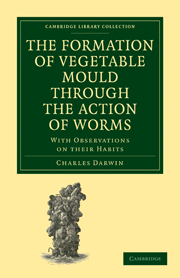Book contents
- Frontmatter
- Contents
- INTRODUCTION
- CHAPTER I HABITS OF WORMS
- CHAPTER II HABITS OF WORMS—continued
- CHAPTER III THE AMOUNT OF FINE EARTH BROUGHT UP BY WORMS TO THE SURFACE
- CHAPTER IV THE PART WHICH WORMS HAVE PLAYED IN THE BURIAL OF ANCIENT BUILDINGS
- CHAPTER V THE ACTION OF WORMS IN THE DENUDATION OF THE LAND
- CHAPTER VI THE DENUDATION OF THE LAND—continued
- CHAPTER VII CONCLUSION
- INDEX
CHAPTER IV - THE PART WHICH WORMS HAVE PLAYED IN THE BURIAL OF ANCIENT BUILDINGS
Published online by Cambridge University Press: 29 August 2010
- Frontmatter
- Contents
- INTRODUCTION
- CHAPTER I HABITS OF WORMS
- CHAPTER II HABITS OF WORMS—continued
- CHAPTER III THE AMOUNT OF FINE EARTH BROUGHT UP BY WORMS TO THE SURFACE
- CHAPTER IV THE PART WHICH WORMS HAVE PLAYED IN THE BURIAL OF ANCIENT BUILDINGS
- CHAPTER V THE ACTION OF WORMS IN THE DENUDATION OF THE LAND
- CHAPTER VI THE DENUDATION OF THE LAND—continued
- CHAPTER VII CONCLUSION
- INDEX
Summary
Archæologists are probably not aware how much they owe to worms for the preservation of many ancient objects. Coins, gold ornaments, stone implements, &c, if dropped on the surface of the ground, will infallibly be buried by the castings of worms in a few years, and will thus be safely preserved, until the land at some future time is turned up. For instance, many years ago a grass-field was ploughed on the northern side of the Severn, not far from Shrewsbury; and a surprising number of iron arrow-heads were found at the bottom of the furrows, which, as Mr. Blakeway, a local antiquary, believed, were relics of the battle of Shrewsbury in the year 1403, and no doubt had been originally left strewed on the battle-field. In the present chapter I shall show that not only implements, &c., are thus preserved, but that the floors and the remains of many ancient buildings in England have been buried so effectually, in large part through the action of worms, that they have been discovered in recent times solely through various accidents. The enormous beds of rubbish, several yards in thickness, which underlie many cities, such as Rome, Paris, and London, the lower ones being of great antiquity, are not here referred to, as they have not been in any way acted on by worms.
- Type
- Chapter
- Information
- The Formation of Vegetable Mould through the Action of WormsWith Observations on their Habits, pp. 176 - 229Publisher: Cambridge University PressPrint publication year: 2009First published in: 1881



